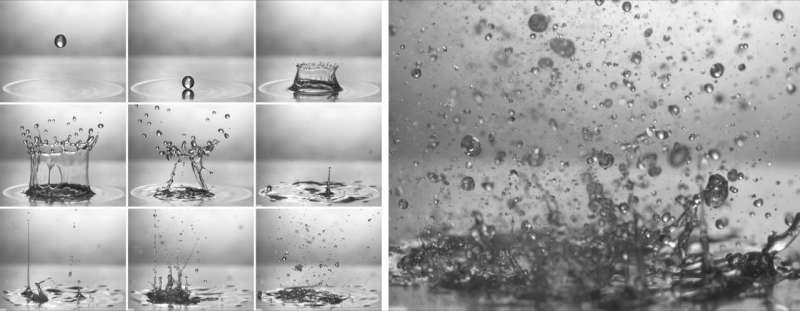'Explosive' hot oil droplets from cooking may lead to air pollution risks

Cooking in a frying pan with oil can quickly become dangerous if "explosive" hot oil droplets jump out of the pan, leading to painful burns. But these droplets may be doing something even more damaging: contributing to indoor air pollution.
A group of researchers from Texas Tech University and Utah State University exploring these "explosive droplets" will present their work to uncover the fluid dynamics behind this phenomenon during the 70th annual meeting of the American Physical Society's Division of Fluid Dynamics, being held Nov. 19-21, 2017, in Denver, Colorado.
"We've discovered that a very large number of small oil droplets are released when even a single, small droplet of water comes into contact with hot oil," said Jeremy Marston, an assistant professor at Texas Tech University.
To run model experiments of the explosive dynamics, the team started out with a thin layer of oil—canola, peanut or soybean—and measured the temperature with a thermocouple. "Then, we inject a small droplet of water and record the event with a high-speed video camera," Marston said. "The resulting phenomena is dramatic—you can see the explosive release when the water, trapped under the oil, vaporizes all of a sudden. This causes the oil film to rupture and sends oil droplets flying."
Cooking some common foods, such as a chicken breast, involves a substantial amount of contained water. The higher the water content, the larger the number of these explosive droplet events, which means that even more oil droplets will be sent flying.
"Our research may be particularly relevant to Chinese cooking methods in which water is added to hot woks," Marston said.
Among their more surprising findings, according to Marston, is that released oil droplets can be submicron sized, making them potentially hazardous because they can be inhaled. The group is currently assessing the true size distribution of oil droplets released and how far into the ambient environment they can reach with or without proper ventilation.
"It's known that millions of deaths worldwide occur due to indoor air pollution, but we don't know yet how much cooking in poorly ventilated kitchens contributes to it," Marston said. "We're planning to conduct a detailed study to quantify how much impact kitchen-based aerosols have on indoor air pollution. Ultimately, we hope that our research can guide designs for improved ventilation systems to remove these ultrafine aerosols."
Marston and his group are focusing on more detailed imaging with high-speed video. "To explore the fundamental science, we'll perform three-dimensional volumetric imaging and thermal imaging to assess the dispersion of the aerosols released in cooking," he said. "We'll also perform some preliminary trials using a new air curtain that could be integrated into current ventilation systems. And since some of the droplets are inhalable and potentially hazardous, we're also planning to use an 'aerosol particle sizer' that can measure down to the nanometer sizes to see just how small these particles can be."
More information: "Out of the frying pan: Explosive droplet dynamic," by Jeremy Marston, Chao Li, Tadd Truscott, and Mohammad Mansoor, Nov. 19, 2017, in Room 505 in the Colorado Convention Center. meetings.aps.org/Meeting/DFD17/Session/A12.3
Provided by American Physical Society





















